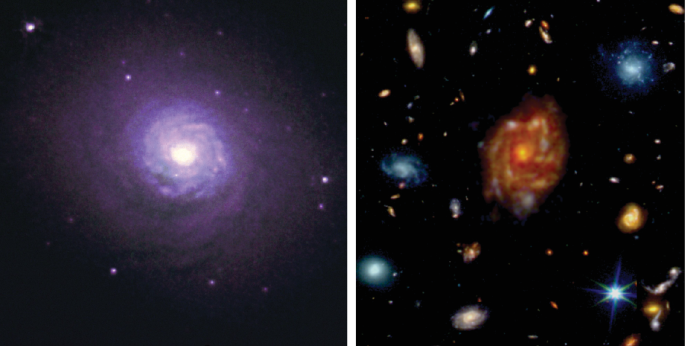As the Hubble Space Telescope celebrates its 35th year in orbit, this issue of Nature Astronomy includes two papers which mark JWST’s continued progress towards similarly reshaping our view of the cosmos. However, a proposed reduction to NASA’s funding could delay or even prevent the launch of its next flagship space observatory.
The science goals behind the launch of the Hubble Space Telescope (HST) in April 1990 were intentionally broad. When Lyman Spitzer made the case for developing space telescopes to see beyond the distortions of the Earth’s atmosphere in the 1940s, he was clear that their aim would be ‘not to supplement our present ideas of the Universe we live in, but rather to uncover new phenomena not yet imagined.’ This was particularly true in the realm of extragalactic science, where hopes rested on HST’s capacity to see deeper into the Universe than had previously been possible.
Over the next decades, the space that opened up before Hubble did indeed reveal many ‘phenomena not yet imagined’ beyond the Milky Way: supermassive black holes that are neither a theoretical conjecture nor even a rarity but reside in the centres of most galaxies, for instance, and the ‘bewildering’ density of galaxies as probed by the Hubble Deep and Ultra Deep Fields. Since the majority of those active in astronomy today did not start their doctoral studies until HST was already well established — the editorial team at Nature Astronomy included — it can be difficult to fully appreciate the degree to which it has overhauled the field.
Given this context, it is perhaps not surprising that the James Webb Space Telescope (JWST) seems to be triggering a comparable evolution in extragalactic science — an evolution highlighted by the two high-redshift studies that feature in this issue of Nature Astronomy. In an Article and accompanying Research Briefing led by Weichen Wang, the joint efforts of NIRCam and NIRSpec identify a disc galaxy at redshift z = 3.25 (see the right panel of Fig. 1), whose exceptionally large size and mass are neither predicted by simulations nor observed elsewhere at that epoch. Meanwhile, Jakob Helton and colleagues use MIRI photometry to show that the z = 14.32 galaxy JADES-GS-z14 underwent rapid mass assembly at early times, adding to the evidence that massive galaxies formed earlier and faster than was thought pre-JWST (S. Carniani et al., Nature 633, 318–322; 2024). Both findings indicate gaps in current galaxy evolution models, and so join the multitude of others that together are motivating new and creative ways of thinking about the early Universe.

B. Whitmore (STScI), and NASA Co-investigators: Francois Schweizer of the Carnegie Institution of Washington, Washington, D.C., and Claus Leitherer, Kirk Borne, and Carmelle Robert of STScI (left panel); CC BY-NC-ND 4.0 (right panel)
Left: Galaxy NGC 7252, at redshift z ~ 0.02, imaged by HST a few years after launch. Right: the Big Wheel galaxy, at redshift z = 3.25, imaged by JWST.
That such results are becoming more routine signals that JWST is already starting to raise our ‘discovery threshold,’ in that we have almost come to expect — or at least to feel comfortable with — the arrival of new high-redshift observations that we cannot explain. It is exciting to witness extraordinary observations becoming ordinary in a matter of years; but in light of the recent and drastic proposed cuts to the NASA budget, the capacity of the USA to continue this trend after JWST’s planned 10-year mission is unclear.
Parallel to ESA’s Euclid and the upcoming launch of CNSA’s Xuntian in 2026, NASA’s next major space observatory is intended to be the Nancy Grace Roman Space Telescope, whose instruments were integrated to its spacecraft at the start of this year. By spending 75% of its time on imaging surveys in the optical and near infrared, Roman would create deep-sky panoramas potentially littered with ‘phenomena not yet imagined’: think the 2030s’ answer to the Hubble Ultra Deep Field. But whether Roman makes its 2027 launch date — or any launch at all — now depends on substantial revisions being made to the proposed 2026 US fiscal budget. The current presidential proposal, which stipulates a two thirds cut to NASA’s astrophysics funding and a shift of focus away from scientific discovery in favour of human exploration, reflects a significant recasting of values by the current government and is an alarming starting point for further discussions in Congress.
Substantial swings away from fortune are not unheard of for NASA, which faced progressive reductions in funding as the Space Race drew to a close late last century. It is also inevitable that the priorities of those in power will not be a constant, and that those priorities will be used to weigh up the material cost of our once-extraordinary things. However, the proposed abrupt abandonment and early termination of projects that are already in advanced stages would likely derail careers in addition to degrading the pace of scientific progress. To us at Nature Astronomy, the potential loss of science as well as this tangible human cost are unwelcome. We hope, through the content in our pages, to highlight the value and importance of both.
Rights and permissions
Reprints and permissions
About this article
Cite this article
A succession of space telescopes.
Nat Astron 9, 617 (2025). https://doi.org/10.1038/s41550-025-02574-y
-
Published: 21 May 2025
-
Issue Date: May 2025
-
DOI: https://doi.org/10.1038/s41550-025-02574-y
